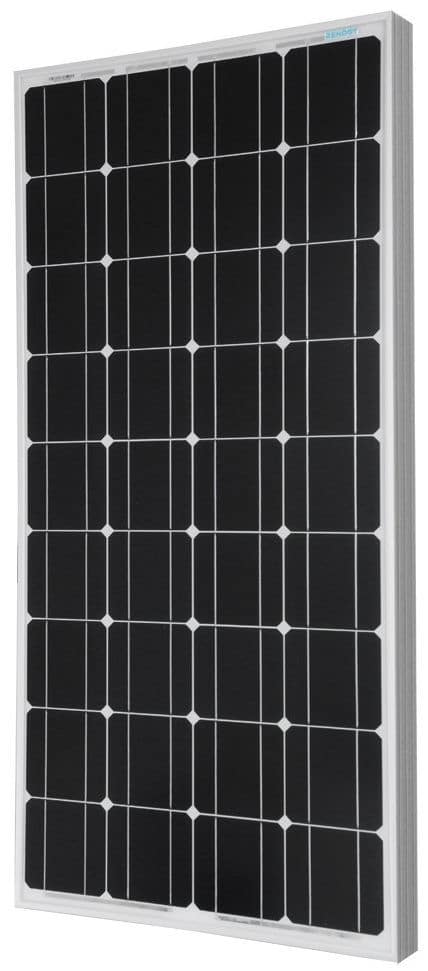
Connecting Solar Panels Together
How to Connect Solar Panels Together
![]() Connecting solar panels together is a simple and effective way of increasing your solar power capabilities. Going green is a great idea, and as the sun is our ultimate power source, it makes sense to utilize this energy to power our homes. As solar power becomes more accessible, more and more homeowners are buying photovoltaic solar panels.
Connecting solar panels together is a simple and effective way of increasing your solar power capabilities. Going green is a great idea, and as the sun is our ultimate power source, it makes sense to utilize this energy to power our homes. As solar power becomes more accessible, more and more homeowners are buying photovoltaic solar panels.
However, these photovoltaic solar panels can be very costly so buying them over time helps to spread the cost. But the problem then becomes how do we connect these extra solar panels together to increase the voltage and power output of what’s already there.
The trick here when connecting solar panels together is to choose a connection method that is going to give you the most energy efficient configuration for your particular requirements.
Connecting solar panels together can seem like a daunting task when you first start to look at how it should be done, but connecting multiple solar panels together is not that hard with a little thought. Wiring solar panels together in either parallel or series combinations to make larger arrays is an often overlooked, yet completely essential part of any well designed solar power system.
There are three basic but very different ways of connecting solar panels together and each connection method is designed for a specific purpose. For example, to produce more output voltage or to produce more current.
Solar photovoltaic panels can be electrically connected together in series to increase the voltage output, or they can be connected together in parallel to increase the output amperage. Solar pv panels can also be wired together in both series and parallel combinations to increase both the output voltage and current to produce a higher wattage array.
Whether you are connecting two or more solar panels, as long as you understand the basic principles of how connecting multiple solar panels together increases power and how each of these wiring methods works, you can easily decide on how to wire your own panels together. After all connecting solar panels together correctly can greatly improve the efficiency of your solar system.
Connecting Solar Panels Together in Series
The first method we will look at for connecting solar panels together is what’s known as “Series Wiring“. The electrical connection of solar panels in series increases the total system output voltage. Series connected solar panels are generally used when you have a grid connected inverter or charge controller that requires 24 volts or more. To series wire the panels together you connect the positive terminal to the negative terminal of each panel until you are left with a single positive and negative connection.
Solar panels in series add up or sum the voltages produced by each individual panel, giving the total output voltage of the array as shown.
Solar Panels in Series of Same Characteristics
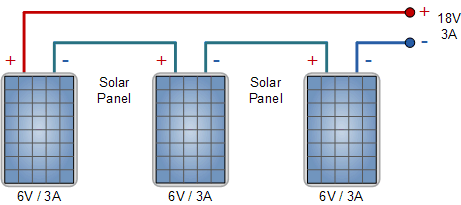
In this method ALL the solar panels are of the same type and power rating. The total voltage output becomes the sum of the voltage output of each panel. Using the same three 6 volt, 3.0 amp panels from above, we can see that when these pv panels are connected together in series, the array will produce an output voltage of 18 Volts (6 + 6 + 6) at 3.0 Amperes, giving 54 Watts (volts x amps) at full sun.
Now lets look at connecting solar panels in series with different nominal voltages but with identical current ratings.
Solar Panels in Series of Different Voltages
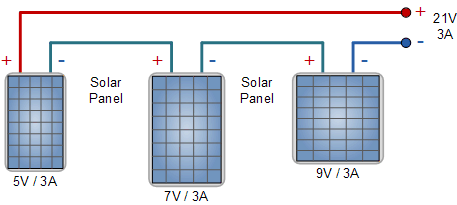
In this method all the solar panels are of different types and power rating but have a common current rating. When they are connected together in series, the array produces 21 volts at 3.0 amps, or 63 watts. Again the output amperage will remain the same as before at 3.0 amps but the voltage output jumps to 21 volts (5 + 7 + 9) .
Finally, lets look at connecting solar panels in series with completely different nominal voltages and different current ratings.
Solar Panels in Series of Different Currents
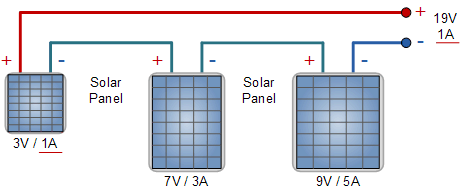
In this method all the solar panels are of different types and power rating. The individual panel voltages will add together as before, but this time the amperage will be limited to the value of the lowest panel in the series string, in this case 1 Ampere. Then the array will produce 19 Volts (3 + 7 + 9) at 1.0 Ampere only, or only 19 watts out of a possible 69 watts available reducing the arrays efficiency.
We can see that the solar panel rated at 9 volts, 5 amps, will only use one fifth or 20% of its maximum current potential reducing its efficiency and wasting money on the purchase of this solar panel. Connecting solar panels in series with different current ratings should only be used provisionally, as the solar panel with the lowest rated current determines the current output of the whole array.
Connecting Solar Panels Together in Parallel
The next method we will look at of connecting solar panels together is what’s known as “Parallel Wiring“. Connecting solar panels together in parallel is used to boost the total system current and is the reverse of the series connection. For parallel connected solar panels you connect all the positive terminals together (positive to positive) and all of the negative terminals together (negative to negative) until you are left with a single positive and negative connection to attach to your regulator and batteries.
When you connect solar panels together in parallel, the total voltage output remains the same as it would for a single panel, but the output current becomes the sum of the output of each panel as shown.
Solar Panels in Parallel of Same Characteristics
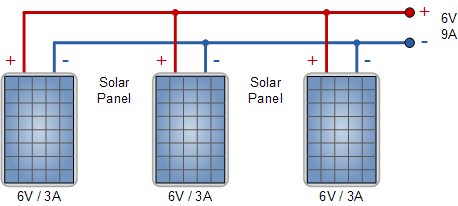
In this method ALL the solar panels are of the same type and power rating. Using the same three 6 Volt, 3.0 Amp panels as above, the total output of the panels, when connected together in parallel, the output voltage still remains at the same value of 6 volts, but the total amperage has now increased to 9.0 Amperes (3 + 3 + 3), producing 54 watts at full sun.
But what if our newly acquired solar panels are non-identical, how will this affect the other panels. We have seen that the currents add together, so no real problem there, just as long as the panel voltages are the same and the output voltage remains constant. Lets look at connecting solar panels in parallel with different nominal voltages and different current ratings.
Solar Panels in Parallel with Different Voltages and Currents
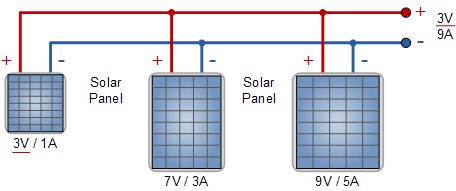
Here the parallel currents add up as before but the voltage adjusts to the lowest value, in this case 3 volts or some voltage value very close to 3 volts. Solar panels must have the same output voltage to be useful in parallel. If one panel has a higher voltage it will supply the load current to the degree that its output voltage drops to that of the lower voltage panel.
We can see that the solar panel rated at 9 volts, 5 amps, will only operate at a maximum voltage of 3 volts as its operation is being influenced by the smaller panel, reducing its efficiency and wasting money on the purchase of this higher power solar panel. Connecting solar panels in parallel with different voltage ratings is not recommended as the solar panel with the lowest rated voltage determines the voltage output of the whole array.
Then when connecting solar panels together in parallel it is important that they ALL have the same nominal voltage value, but it is not necessary that they have the same ampere value.
Connecting Solar Panels Together Summary
Connecting solar panels together to form bigger arrays is not all that complicated. How many series or parallel strings of panels you make up per array depends on what amount of voltage and current you are aiming for. If you are designing a 12 volt battery charging system than parallel wiring is perfect. If you are looking at a higher voltage grid connected system, than you’re probably going to want to go with a series or series-parallel combination depending on the number of solar panels you have.
But for a simple reference in regards to how to connect solar panels together in either parallel or series wiring configurations, just remember that parallel wiring = more amperes, and series wiring = more voltage, and with the right type and combination of solar panels you can power just about any electrical device you may have in your home.
For more information about Connecting Solar Panels Together in either series or parallel combinations, or to obtain more information about the different types of solar panels available, or to explore the advantages and disadvantages of using solar power in your home, then Click Here to order your copy from Amazon today and learn more about designing, wiring and installing off-grid photovoltaic solar electric systems in your home.





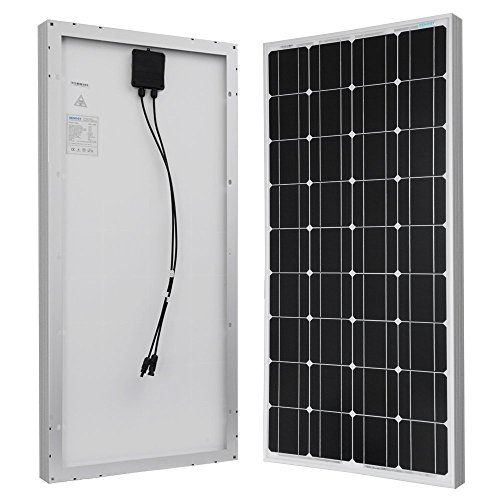

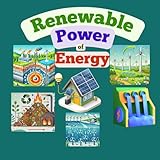



Hi,
Hope you are well,could you please advice why my 2pannels of 100watts each mounted to 2.5m cable to 2pcs charger controller of 20ah each then to 1pc inverter {800w}.
1) It feeds an electric fence with an energizer {12v supply 9.9v to electric wire}
2)About 6pc security bulbs 9w each
3)About 5pcs bulbs in the house 9w each
Now, if i leave the electric fence on during the day without using anything else,it will read 75% charge in the evening,once i switch on the both security and house bulbs,the charge last for a bout 2hrs then it go off competently,could it be a connection problem? I was told that 200watts solar panels can accommodate electric fence,about 20bulbs and also my TV when i was purchasing it 2 weeks ago but to my surprise!!!!
I guess not, please ask the person or shop from where you purchased your equipment.
am using 12v solar tv but during day time when the battery is charging then rmthe battery get to 13.7v the the tv start to restart itself unless i remove the pv cable then battery drop to 12.6 before its works and the charge controller Voltage is not adjustable, what should i do
Buy a 12 volt regulator for your tv.
can i use 2 controllers to 1 battery each controller has it own panel
Not advisable as they will compete against each other to regulate the battery.
am using 155w panel with 2mm cable i want to add my extra 70w panel to it which will be 225w but i think the 2mm cant handle the 225w, so i have decided to connect the 70w panel cable straight to the controller, which means i will get 2cables coming into the controller 155w and 70w cables, please is it possible?
The cable diameter will depend mainly on current capacity and length for voltage drop reasons. Yes you can wire each panel separately to the charge controller if required.
can i use both panels 70+155w = 225 with 2mm2 flexible cable
Hi, kindly advice me, is there a maximum amount of panels that should not be exceeded in an array?
I have two 300w (44v, 9.5A) panels connected in parallel to a 24v-3000w inverter. Now, I have 4 more of same panels to be added to the array making a total number of 6 panels (6x300w=1800w)
From my calculations, i should prepare for 75-80 amp cabling which my existing wiring can handle, however, can the 4mm connecting cables that come with the panels be able to bear the load?
According to your comments, each branch current is 9.5A, therefore the 4mm connecting cables can handle this current
i have monocrystalline 100 watts and poly 167 watts , isnt ok to parallel it and to use on grid 600 watts inverter?
Hello.. i have 4 150w pannels attached with pair of 250 amp batteries in series I want to ask that can i connect another pair of 150 watt panels to batteries separately in series setting what would be affect. Please xplan..
I Need some help
I have 3×265 watt 24 volt panels and a total of 1100AH battery’s and a 3.5kva inverter and a MPPT charge controler Rated charge current: 40A
Max.PV input power: 12V/520W,24V/1024W
Battery voltage range: 9V~32V
Max.PV open circuit voltage: 100VDC
My problem is that I have it connected in parallel and the charge controller says that the charge is 5.7amp would it be better if I connect it in series and will the charge controller be fine?
please can you help?
What’s wrong with 5.7 amps
If each panel is already individual 24 volts then I would run them as parallel to get higher amperage. Running panels in series adds volts together but leaves amps constant, which 5.7 is probably what is default for one panel?
I have two 250w 30v panels connected in parallel to a 30a charge controller charging a 24v battery system. I have come by two more identical panels. I’m replacing my charge controller with a 60a model. Is it OK to just connect all four panels using a 4-way coupler, or should I use a combiner box?
Whichever is easier for your installation
i am presently collecting items to make my off grid cabin, So far i have 4(100) watt panels and am looking for a mttp charge controller as i have a pwt and its not working so well.I am also looking to purchase a wind turbine but not sure how much watts i need along with the solar panels.I have a 3000 watt inverter and i am looking for advice on the best way to set this up and if 6 volt golf cart batteries are better than 12 volt deep cycle batteries. I want to live totally off grid running some dc lights,a small chest freezer, a washer front load on times,and tv/lap top. Can you help with diagrams,info on series or parallel set up for a 12 volt system.What size of wires i need from panels and turbine, to charge controller.to bateries plus anything i may have missed.Thank you in advance for any advice ,suggestions and pictures/diagrams
Hello
i need some information about my solar panels system.that i think , they are not giving me full power
I buy last year
4 solar panels of 150w,
1×200 amp leaqued 12v battery ,
1000w / 12v inventor ,
12 or 24 volt 50amp solar charge controller
now i want now how much thses panals produce power.
i often check my charge contoler reading in peek time (1200 to 1400) , it show only 19amp maximum comin from the panals. my all 4 Solar Panels are in Parallel of Same Characteristics. please tell me whats the problem.
a friend said me that a 150w solar panal produce 6.5 to 7amp. so by this , they want to produce 26 to 28 amp (4*7)but they are only giving me 19amp
Please assist me in this situation
Why do you think that your panels should be supplying a full 150W all of the time. Your solar panels may be rated at 150W and can supply a maximum current of 12.5A (150W/12V) each but its the load they supply that dictates the current, not the panel. If your batteries are nearly always fully charged, then their charging current will be low. If you want more current to flow try increasing your connected load, or just accept you have bought a system bigger than you need.
I’ve a water pump 60V and 15amp DC max and 12V solar panels available with 7 amp of current. For proper operation how many panels have to be attached? How many in series and how many parallel?
And if I’ve 24V solar panels with 8amp current?
Then you will need two strings of 5 panels per string (5 x 12). 10 panels in total for a 900W load.
But would the two strings of 5 panels per string at one string being 60volts/ 7 amps, for the both strings of the parallel panels, wouldn’t the amperes add up to only 14 amps dc. Of did I calculate it wrong?
14 amps is near enough. Your pump will not pull the full 15 amps anyway. You can add an additional string if you think you need it.
I have 33/190w panels on the roof with a 5kw sunniboy inverter, when I check the readout of the inverter the difference in voltage produced by each string is nearly the same, say 380v yet the current produced will be Double from one string to the other, say 9amp on one string and 4.4amp on the other. I got on the roof and checked the wiring, the installer has 22 panels on 1 string and 11 panels on the other string the larger string produces the larger amps and around twice that of the smaller strin. My question is why would the inverter show nearly the same voltage produced by both strings yet one string has twice the panels, this is confusing me. The panels are in Series.
One double parallel string: 11 + 11 = 22, which would give double the current, and one single string: 11 panels.
Hi I have 8 panels on 250 watt each with 34v and 8 ah And 4 batteries of 150ah 12v with c10 rating
What would be the right way to connect the panels and batteries so that they would get charged easily.
Hi and I am new to solar panels and I just bought 3 panels for 140 watt each, rated:18.5volt, and 7.57amps and 1 panel for 50watt rated: 18volt and 2.78 amps and 200amps battery and 800 watt solar power inverter. which wire size should I used for the panel to the charge controller? How should i wired my panel in series or parallel so that battery would get charge easily and fast?
am using 70w panel 12 v40ah battery, am using 12v solar tv 26w 2.6A and 14w 1A satelite decoder, all loads is 40w 3.6A, if i on the tv and the decoder on during day time my battery find it difficult to charge and i can’t get full charge, so i have to off all load to get fully charge before i can watch the tv in the evening for about 5-6hrs, i want to know to get full charge with my loads on during day time should i go for other panel to be added to the 70w panel am using and if yes how many watts of panel should i go for it to be added to the 70w to charge the 40ah battery
The proper charging and discharging of deep cycle batteries is important to maximize battery performance as both under- or over-charging batteries can significantly reduce battery life. The greater the state of discharge, the more the battery becomes weakened so discharge (called Depth of Charge) should not be more than 50%. Thus: (40Ah x 12V)/40W = 12 hrs x 50% = 6hrs, which is what your seeing.
Charging deep cycle lead-acid batteries requires a constant current and voltage via your charge controller which your 70w panel may not be able to provide. Just because your panel is rated at 70 watts does not mean it will constantly generate 70 watts of power, as the amount of solar irradiance, sun hours, efficiency, etc. will all affect the output power. You may need additional wattage for what you need.
am using Gel Battery, i want to additional 80w panel and 60ah battery, which will be 100ah battery 150w panel , hope will be ok for me.
hello sir how are you?i would like to ask that 2400 va solar inverter how many solar panel can be connected i mean how many watts 2400 watt panell can i connect with that .thank you .
Good day. I have 4 panels( 40 watts a panel and 2.2 amps each) wired parallel. I got a panel for Christmas which is 100 watts and 5.8 amps All panels are rated at 17.1 volts. I got 4 6volt batteries and a 20 amp charge controller. How should I hook up the 100 watt panel to my system ? If possible?
Thanks
Shawn
Hi, I need a little help on fixing my solar panels in Africa.
I have twenty (20) of 100W solar panels.
I also have ten (10) 12V 100Ah batteries
I also have 2000W power inverter.
And 12v/24v control board charger. I have more than 10 of the control board chargers.
I have already done the connection but it seems it’s not able to power my freezer at home. All the professionals technicians are very very far from my home.
Let me describe how I did my connections. I connected all the negative terminals on the solar panels together and the positive also together. So I have all eight (8) panels connecting to one control board and then all the eight (8) batteries to the control board charger also. And from the batteries to 2000W power in inverter. First I was able to use the freezer but not anymore. Any help on how to connect them properly. Do I need to use 3 control board chargers or just one is okay.
Anyone with assistance who is willing to help me out can message me on.
Thanks and God bless.
From your connection, the solar panels are connected in Parallel, this means that your wattage has not increased but your current has, from my experience doing solar, a 100 watts solar panel has about 4.7- 5.4 current. if i go by this number you have 100Watts, and about 4.7A * 20 = 94A. But for us to go further you have to provide me with some information.
How many volts in your 2000w inverter 12V or 24V?
What is the maximum Wattage input and Current(A) of your solar charge controllers?
Hello
I hope you will assist me with more information about my solar panels system I buy 2x95w solar panels, 2x12v sealed batteries,1000w modified 24v input inventor , 12 or 24 volt 20amp solar charge controller now my challenge is how to connect this system so that it can work my challenge are we don’t have any power in the house
Please assist me with this situation
no matter if you connect PV in parallel or serie , that’s if you thing in final power , main thing is if Charge controller supports voltage Sum of PV as input , if it support you can connect : PV in serie as charge controller input Charge controller output to batteries and in parallel , the load if it is in 24 V , if not this output should be connected to inverter input (24 V input ) and load to de output inverter. take in acount that you have only 1000 W so you have to be sure about what or how many devices you will connect to your system.. hope this help you to solve your problem !
Hello,
I have 4 panels of 36V – 300W – 8.31A each. What kind of controler, inverter and batteries would I need to begin a system.
Main thing is what is the load (how many Watts) you want to connect to your system an how many hour it need to be working .This power will determinate your system , included if your PV are enought
If you have 300W, you can run a 1000 watts load using a 2000VA(24V) inverter, you will need 2 pcs of 200ah 12V Batteries, 24V 40/50A charge controller, with at least 1600W Max.PV Input (PWM or MPPT) your choice, and this system can power a 1000W load for around 9hrs if the batteries are fully charged. You will need to connect your panels in parallel. so you have 1200W for 33.24A. Here is the formular for calculating Battery bank or run time A= Load(W) * Hours / Voltage(system voltage which is 24 in this case) = AH (battery bank) thus: 1000*9/24 = 375AH approximetly 400AH, which is better as 200ah * 2.
Great, got it. I bought an 80A MPPT controller, a 24V 3000W pure sine inverter and 8 golf cart 6V 225ah batteries. Got one more question, My panels read, (Vmpp 36.09) and (Voc. 44.90) I suppose they are 24V right? If I want to buy 2 more, do they have to be exactly the same volt and watts?
No, they are 36 volt panels
OK, thanks a lot.
I enjoyed reading your article. I inherited some equipment that I would like to use for an off grid system. What would you suggest would be the best configuration for 3-Hanwha 260W, 38.1voc, 8.42imp, 2-Suniva 240W, 37.5voc, 8.12imp, 1-Sharp 235W, 37.8voc, 7.84imp panels with a Flexmax60 controller, Outback FX2524T inverter and 8-200ah batteries? In my mind (if I understood what I read) the plan would be 2-260W in series, 2-240W in series and the mismatched panels in series. Would this be correct?
Yes, your idea of a 3×2 array would work but your mismatched branch would only operate at the lowest panel rating.
Thank you. In your opinion would the output voltage of the array be within the parameters of the Flexmax (rated at 150v max)?
Dear can you tell me answer of this question Fore different ratings of Solar panels connected in series 80w, 85w, 83w and 80 watt respectively. how can we calculate the current (Amp) and Voltage (V) . If we consider 12v Please tell me answer briefly of this question.
48 (4*12) Volts, 6.67 (80/12) Amperes max at full sun.
is it possible to run solar panels in series to twelve volt batteries in series (matching 60 volts) and then hook up a twelve volt inverter to the batteries
Yes, but the inverter will only connect to one 12 volt battery.
How do l connect two 200 watts solar panels to a 24 volts off grid system to get the maximum power for a fridge?
What is the differences between monocrystaline and polycrystaline panels ? Do these solar panels perform differently for ab off grid system?
I just got to know this site today and i am much blessed
thanks a lot.
Sir, i have one solar pannel unknown. It show open current volt is 59-60v. I want a charge 12 v battery, so. Which charge controller use, please solution.
I have 5 265w panels My battery bank is 12v If I connect parallel will I be able to connect to my battery bank?
I guess so, if your panels are 12 volt rated.
Hello Sir, l have 2 panels with different watts, one has 10 watts and another one has 15 watts, i want t connect them together , can you tell me wich method is good for my panels?
Whichever one works for your panels
Sir, can you please tell me what will total wattage in total if I connect two 250 watt 24 v in series ,,, will it be 500 watt 48v or it will be 250 watt 48v as one of my known told me that it will remain 250 watt but of 48v .. pls reply soon
Connected in series you will have 48 volts, 500 watts at 10 amps.
Connected in parallel you will have 24 volts, 500 watts at 20 amps.
Connection in series method voltage gets added but capacity reamins same.
Connection in a parallel method Voltage remains same but capacity gets added.
Am I right Mr administrator.
PL correct me. If I m wrong
Yes you are correct.
I want to design an off grid solar system. Currently l have 2*200watts monocryataline 1*100watts monocrystalin and a 1 *120watts solar panel.I also have a 24 volts Fortuner Imvertor
Will the above components suffice to meet the demands stated?
Possibly, you have 620 watts of free solar power available.
Sure administrator, is this sufficient to offer power for entertainment ,fridge, lights for an 8 roomed house including the dish. The battery Bank consist of 2*200ah deep cycle gel BATTERY
Possibly, calculate your energy requirements and consumption.
Thank you for your ellerborations on solar panel array configuration. Using the clean energy has never beem that easy
What a fantastic article! It’s been difficult finding articles that go beyond the normal ‘parallel adds current, series adds voltage’ type advice. Really very, very good! 🙂 Humbly, I might suggest adding details of how partial shading impacts series and parallel installations differently, and maybe a few comments about blocking and bypass diodes for the ultimate reference!
I’m hoping I’ve read enough now to come up with a decent off-grid solar design for my caravan. I’ve been plagued by shading nuances because my 10 x 100W panels will be located 2 on the left-side, 6 on the roof and 2 on the right side, meaning the three strings will receive very different irradiance patterns throughout the day.
I’m planning to have separate MPPT controllers for each string, 2 x Victron Energy 15/75 for the sides and 1 x 50/75 for the roof. Both side strings will have their 2 panels connected in series in order to maximise string voltage (i.e. greatest flexibility for the MPPT controller and minimise resistive losses). The panels are all going to be identical 100W, 22V (Voc), 6.04A (Isc) with optimum power at 17.7V @ 5.65A. My main controller can handle 50A battery side and up to 75Vdc PV side so I was planning on wiring the 6 roof panels in two parallel sub-strings of three panels in series. This maximises system operating voltage at 53.1V (17.7V x 3 = 53.1V), minimising resistive losses with only 5.65A flowing through each sub-string and only 11.3A (5.65A + 5.65A = 11.3A) back to the controller, whilst Voc remains within spec at 66Vdc. 600W / 12V = 50A is theoretically at the limits of the controller output, but, hey, those panel output power specs are likely unachievable in practice 😉 I’m planning on using 4mm2 solar cable for the sides and 6mm2 for the roof.
Facing my caravan southerly, I figure the left-side would maximise capture of the morning sun, the roof 6 would capture as much as they can (i.e. being flat) during the day, and the right-side would maximise capture in the late afternoon / evening.
I’ve spec’d the system for winter usage where I figure on 20% practical performance compared with ideal conditions. Given the minimal real-estate on a small 2-berth caravan, I figure this design will get me maybe 150W on average during my winter outings.
I’d welcome your expert view on my design and would be eternally grateful for any comments, improvements or ‘gotchas’ you might have.
currently i am getting only 20 to 22 amp max.
hi,
i have 5 solar panel i made diy solar panel using sunpower solar cell and encapulate with silicone.now when i check volt is 18 and amp is 5 in 11am.i am using esmart mppt solar controller.problem is that short amp is 5 but using amp is only 3.2. to 3.5amp max.i am not using any bypass diode because sunpower solar cell no need bypass diode.using cable 10mm and distance 10meter.using 150Ah lead acid battery.
Can Mur460 diod be installed in a solar panel as blocking diod is 4amp 600v
THE MUR4xx series are rectifying diodes rated at 4 Amps so it depends on the current rating of your solar panel. If it is less than 4 Amps then it could be used. The 600V DC reverse voltage should not be a problem.
Hello, the information is very helpful.
ADDITIONALLY, is it possible to connect panels together in a SERIES-PARALLEL configuration without any harm the the panels?
PV panels can be connected together in any combination you want.
yES “THE SOLAR MAN”
i have 2 ge panels on roof of my rv…one is 6volt-55watt ,other is 12 volt 100 watt./running( 2) 6 volt trojan batteries (ran as a 12 volt) how can i best wire the panels? i understand from your advice that neither series or parallel is ideal
For optimum performance it is better to use PV panels within the same system with the same voltage and power ratings.
Hi I have 6 300w pannels with a 48 volts inverter and 24/48 volt charge controller and four batteries 175 ah. I want to use it on offgrid ,what system do u suggest I use between parallel or series
Which one is better parralel connection or series connection
The power output will be the same whether connected in series or parallel. The choice of connection will ultimately depend on the specifications of the charge controller or inverter (for grid-connected) used. Having said that, I would prefer series connected as it produces a higher voltage and lower current for a given wattage, so less cabling with smaller cross-sectional areas can be used.
Is a gud explanation, tanx alot
Hi!
I am designing a grid connected solar array of approx. 48 kWp that should supply a block of appartments. All the panels are the same model and I know home voltage is 230V. Knowing that a DC/DC converter can amplify or reduce the amperage of the array, Do you know what are the criteria to establish the series/parallel configuration of the panels? Should the voltage output of the array equal 230 V? should it be higher? Is there a rule of thumb or something as such?
Any advice would be very much appreciated.
Thank you in advance!
Tony
A grid-connected system uses a Solar Inverter to take the DC output from the PV array and converts it to an alternating current (AC) supply. But the inverter does not just simply convert a DC input to any old AC output waveform, but instead ensures that the AC waveform it produces matches the frequency and magnitude tolerances of the connected power grid. Also good quality inverters use maximum power point tracking (MPPT) to maximise the amount of energy from the solar PV array as Power In = Power Out.
Solar inverters are generally designed to take advantage of the solar modules configured as a high-voltage PV string array usually from about 200 VDC to 500 VDC “open-circuit” voltage (Voc) depending on model to supply the 230 VAC nominal grid output voltage. Also the inverters maximum input current rating should not be less than the arrays short circuit (Isc) rating. Then ensure that the series/parallel configuration of the array matches the Voc and Isc requirements of the chosen inverter.
Hi,
I have 8 x 250W panels, where 2 each are connected in series and the 4 sets of series connected in parallel. They are connected to a 60A, 48V charge controller (PWM) and 4 x 12V batteries in series. However, using my meter, i have never gotten an output from the panel of more than 4.5Amps. Is this normal, what could the problem be? I live in a very sunny country. Thanks
As explained many times here, just because your panels are rated at 250W does not mean they will supply 250W continuously. They will supply the amount of power required by the connected load. Elecrically empty the batteries and then see what the current value is when they have to charge discharged batteries.
Hi can I mix battery bank ampere, scenario have 2x 120w panels in series, and 4x 12v batteries in series 48v system ranging from 100, 102 to 105amps each with a 30amp mppt solar charger. When I connect all 4 batteries to the charge controller the charge control goes to Ovl and then Off and never charge , but if I disconnect batteries and leave only one connected it charges okay. ?? Is do we need more solar panels to charge all 4 batteries or is the different amps on battery a concern?? Or can we add 3 more 120w panels?
Obviously Ovl means “overload” and your controller is automatically switching off for safety reasons. Check the ratings of your charge controller.
Hello
I have 24 solar panels 250W each which I want to connect to 48V Victron inverter and battery bank. What is the most efficient way to connect solar panels to achieve 48V?
An array of four panels in series (4 x 12V = 48V) and six parallel rows, 4 x 6.
This is incorrect, 250w panels would give around 30v each, so that would be 2x30v in series =60v x12 in parallel.
As always, limited information is supplied as only the wattage size is given, so a12 volt panel output is assumed. To give a Vmp of around 30V, a 60 cell, 24 volt panel is required which is I guess what you have assumed.
Great Site!
So, I have 18 panels, about 340 VDC and an inverter that has a minimum 150 VDC input. Would I get more output if I split them up into two 9 panel parallel strings?
Many thanks
Rob
No, the wattage rating of the panels is the wattage rating of the panels no matter how you connect them.
Hello,
Great information here. I am doing a solar install on my sailboat. I have the following:
* One 120 Watt, 18 Volt, 6.66 amp Panels
* Four 100 Watt, 17.7 volts, 5.7 amp Panels
My plan is to install all 5 in parallel but I’m now rethinking this based on the information provided here. I think I should wire the 4 identical panels in parallel. I would then wire the 120, 18 volt panel on its own. My question is do I run them all to the same controller, perhaps meeting at a bus bar that then goes to the controller? Or…should I purchase a separate smaller controller for the 129 watt panel and run two controllers to the battery?
Note – I’ve purchases a Victorn 100/50 MPPT controller which is more than enough to handle all of the above. My boat has a 12 volt house batter bank.
Thanks much for any advice you can offer.
Ed L
It would be a smart move to connect the four 100 watt panels together in series, as they are identical panels. In parallel currents add, voltage is the same so you can use parallel connection to boost current output. Connecting two charge controllers to the same battery bank is not a good idea as the two controllers will compete against each other to charge the batteries.
Then what to do with the fifth pv panel. In parallel, currents add but voltage mismatch is more drastic. At low irradiance this generally not a problem but at full sun the voltage output will be reduced slightly as the lower voltage panels stop generating power and now dissipates it being controlled by the larger panel. However, for your five panels the mismatch is minimal, so the power loss at full sun only will also be minimal, so connect them all in parallel.
Hi,
A solar panel is build up with many cells combining in serial method. Attaching another panel is more similar to expanding the size of one panel with higher voltage… So lowest amp is the current in one cell.. then, is the current (amperage) depend on one cell ?
I have many panels with different specs and going to buy a hybrid charging controller (GW5048D-ES ) since I have 1 KA battery bank. MPPT charging voltage is 125~550 in according to its spec…
01). is it loosing efficiency by connecting panels in serial ?
02). When connecting in serial, higher voltage is passing through the panel set and is the strength of tabbing wire is enough to increase such a voltage?
Thank you
As explained in the tutorial, solar panels in series increase the total voltage for a given current, so if five 12 volt panels are connected in series then the total voltage output will be 60V ( 5 x 12V), but the voltage across each panel will still be only 12V. The size of the tabbing wire as you call it depends on the load current and its length (DC voltage drop). Solar cell efficiency depends on many factors and not whether they are connected in series or parallel.
24v system. I got 6 260w 24v panels, connected parallel, 4 12v 120A batteries deep cycle connected parallel give 24v.Question is it enough power for 6 x5w led lights and 120w TV for 4 hours per day night time
My understanding its good enough to even run a freezer for 10 hours a day
I have four Renogy 100W polycrystaline panels, two are wired in series, the other two wired in series and then the two sets connected in parallel. I am using 10ga wire ,the panels are 25 ft from 60amp MPPT charge controller (12v output) going into 4 x 6v golf cart batteries, today on July 5th full sun no clouds in Ma. I have 28 volts, 5 amps and 145 watts, shouldn’t i have more output?
Just because you have 400W installed does not mean the panels will supply 400W continuously, they will supply the amount of power required by the load up to a maximum of 400W. Your charge controller will dictate what’s needed.
What type of connectors will I need to add 2 more 100watt panels to my already installed 2 100watt panels. Currently I have 200 watts into a 30 amp mppt charge controller ( in parallel) with 2 125amp Vmax SLR deep cells, I will be adding a third batt.
Thank you
The industry standard connector for the inter-connection of solar panels is the MC4 connector.
Hi sir
I have a 10 000w/48v invector /charger using 4x 12v betteries.
The question is it possible to use the same power that has been produced by this inveter to power up a charger on it and how should be the connection